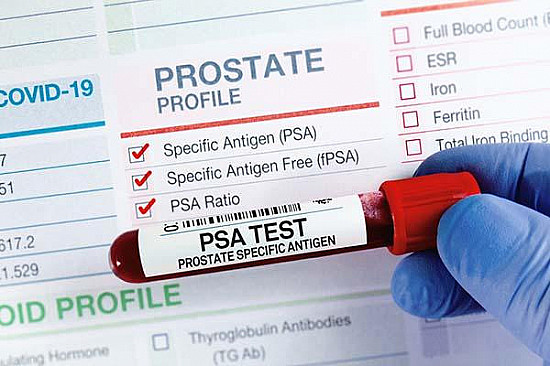Treating advanced prostate cancer
New tests and therapies offer a more optimistic outlook.
- Reviewed by Howard E. LeWine, MD, Chief Medical Editor, Harvard Health Publishing; Editorial Advisory Board Member, Harvard Health Publishing

Today, most men with prostate cancer have what's called low-grade cancer, meaning the cancer is unlikely to spread or affect quality of life or longevity. So, it can be monitored over time with periodic blood tests for prostate-specific antigen (PSA) and sometimes repeat biopsies. This approach, known as active surveillance, enables men to postpone or even avoid treatment and its side effects.
Men with low-risk prostate cancer have only a 2% to 3% chance of their cancer progressing to an advanced stage in the next 10 to 15 years, according to some estimates. But what about a man whose initial prostate biopsy shows an intermediate-risk or high-risk cancer? Or a man who began active surveillance for low-risk cancer but develops a rising PSA or new symptoms suggesting the cancer has become more aggressive?
Evaluation for these men often begins with an MRI scan of the pelvis and abdomen to look for signs that the cancer has spread in and around the prostate gland. A newer type of imaging test called PSMA-PET is particularly groundbreaking, as it helps doctors find smaller collections of cancer cells that other imaging tests may miss.
When cancer does become aggressive, you and your doctor can choose a treatment path depending on the cancer's stage and its likelihood of spreading (estimated using a measurement called a Gleason score). Other factors considered include how much the cancer has already spread, your symptoms, and tolerance for possible side effects. Everyone's path is different, but here are general guidelines you may follow.
High-risk nonmetastatic cancer
High-risk nonmetastatic prostate cancer is localized (meaning that it's still confined to the prostate gland) but has aggressive features that predict future growth. This category often includes people with a Gleason score between 8 and 10 or a PSA level higher than 20 nanograms per milliliter. Treatment can consist of surgery to remove the prostate or radiation. "Many patients also receive androgen deprivation therapy [ADT] — hormone therapy that reduces the levels of male hormones like testosterone — alongside radiation, depending upon the characteristics of the biopsy and MRI findings," says Dr. Marc Garnick, editor in chief of Harvard Medical School's Guide to Prostate Diseases. (To learn more about advanced prostate cancer, read this roundtable discussion led by Dr. Garnick.)
Locally advanced cancer
Here, the cancer has spread to tissues immediately surrounding the prostate, the seminal vesicles (glands that produce semen), or lymph nodes in the pelvic area. Radiation is often the treatment of choice. Before radiation, some men may undergo ADT or doublet therapy (a combination of ADT and chemotherapy).
Surgery is less likely in this case. "Although most physicians are hesitant to operate on a patient with cancer that has spread to lymph nodes, there are studies to suggest that this can be an option," says Dr. Garnick. Experts differ on how long ADT should be used after surgery or radiation for cancer that has reached the lymph nodes. Six months may be sufficient, but some doctors often recommend continuing hormone-blocking therapy for up to two years.
Oligometastatic cancer
This is sometimes referred to as "spot" cancer, where a few small deposits of prostate cancer have spread beyond the gland to three to five locations. Patients may benefit from radiation, chemotherapy, or both. Surgery is still an option if the cancer hasn't spread beyond the pelvis, as part of a combination strategy that also includes ADT.
Advanced (metastatic) cancer
At this stage, the cancer has spread to distant parts of the body, such as the bones, liver, or lungs. Symptoms may include fatigue, bone pain, and urination problems (frequent urge to urinate, incomplete bladder emptying, or urinary retention requiring a catheter to empty the bladder). However, it's possible to have no symptoms.
Treatment can be challenging and typically focuses on managing symptoms, slowing cancer growth, and prolonging life. Still, the outcome is much more optimistic than it used to be. "Three to four decades ago, men with advanced prostate cancer lived an average of 28 to 36 months," says Dr. Garnick. "Today, the average life expectancy is about five to six years."
Treatment includes ADT, chemotherapy, radiation, and immunotherapy (drugs that help the body's immune system fight cancer cells). "A combination of treatments may be used depending on issues such as the patient's overall health, the extent of cancer, and quality-of-life issues," says Dr. Garnick.
Another reason survival rates have increased is the use of anti-androgens, a class of drugs that block the androgen receptor in prostate cancer cells. "These are often introduced if a patient does not respond to ADT alone," says Dr. Garnick. "Whether to add them as double or even triple therapy along with ADT and chemotherapy may also be explored."
Image: © gerenme/Getty Images
About the Author

Matthew Solan, Executive Editor, Harvard Men's Health Watch
About the Reviewer

Howard E. LeWine, MD, Chief Medical Editor, Harvard Health Publishing; Editorial Advisory Board Member, Harvard Health Publishing
Disclaimer:
As a service to our readers, Harvard Health Publishing provides access to our library of archived content. Please note the date of last review or update on all articles.
No content on this site, regardless of date, should ever be used as a substitute for direct medical advice from your doctor or other qualified clinician.
















